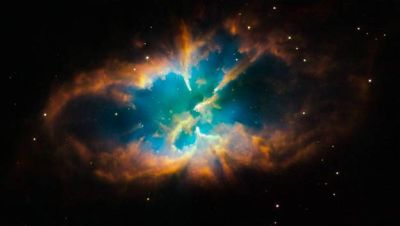25 January 2009

Credit: NASA, ESA, and the Hubble Heritage Team (STScI/AURA)
NASA recently published an exquisite image of a rare spectacular nebula. The picture was acquired with NASA’s Hubble Space Telescope (HST). The object, technically designated as NGC 2818, is the remains of a dead Sun-like star, located inside a distant cluster of stars whose distance is about 10,000 light years away.
When Sun-like stars die, they shed their outer gaseous envelopes into space, forming a fascinating colorful nebula of glowing gases. The hot dense core of the star, which has been producing the energy of the star through nuclear reactions, is then exposed, and evolves into a bizarre stellar object, termed white dwarf. This type of nebulae is termed planetary nebulae, as they often resemble the disks of planets, when viewed through a small telescope.
NGC 2818 is one of rare planetary nebulae in our Galaxy located within an open cluster, a gravitationally-bound agglomeration of stars. Open clusters, in general, are loosely bound, and they disperse over hundreds of millions of years. The evolution of stars that form planetary nebulae typically lasts for billions of years. Therefore, it is rare to observe an open cluster containing a planetary nebula. This open cluster is particularly old; its age is estimated to be nearly one billion years.
Planetary nebulae show various fantastic shapes. The structure of NGC 2818 is complex and difficult to interpret. However, as it is a member of the cluster, astronomers can determine interesting information about NGC 2818, such as its age and distance that might not be known in other cases.
Planetary nebulae expand, and fade gradually, over a period of about 70,000 years. This is a brief period by the cosmic time scale, and it explains the fact that planetary nebulae are rare.
Like a fading ember, the hot, bare core of the progenitor star of NGC 2818 will slowly cool off for billions of years, eventually becoming a black dwarf. Intriguingly, theories show that our own Sun will become a planetary nebula in about 5 billion years!
This HST image was taken in November 2008, with the Wide Field Planetary Camera 2. The colors in the image represent the various emissions of the gasses of the nebula: red represents nitrogen, green comes from hydrogen, and blue is due to oxygen.
Further Reading
Hubble Snaps Images of a Nebula Within a Cluster
http://hubblesite.org/newscenter/archive/releases/2009/05/image/a/
Aymen Mohamed Ibrahem
Senior Astronomy Specialist